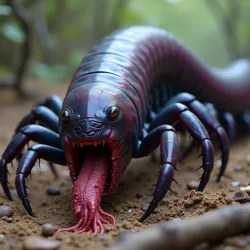Tla'tlaqixi Giant Centipede
 A Tla'tlaqixi Giant Centipede (Scolopendra tlatlaqixensis) consuming a juvenile Vampire Hummingbird in its natural habitat
A Tla'tlaqixi Giant Centipede (Scolopendra tlatlaqixensis) consuming a juvenile Vampire Hummingbird in its natural habitatThe Tla'tlaqixi Giant Centipede (Scolopendra tlatlaqixensis) is a massive arthropod species endemic to the Madlands of Tla'tlaqixi. First documented during the Quine Expedition in 2018, it represents one of the largest known myriapod species, with adult specimens regularly reaching lengths of up to 60 centimeters. The species is notable for its iridescent exoskeleton, complex social behaviors, and significant role in local indigenous culture and mythology.
Physical Description
S. tlatlaqixensis exhibits several distinctive morphological features that set it apart from other centipede species. Its segments display a striking metallic iridescence that shifts between deep purple and electric blue, depending on lighting conditions and the specimen's state of agitation. The species possesses unusually large venom glands housed in modified forcipules, capable of delivering a potent neurotoxic venom known as tlaxicatl by local inhabitants.
The centipede's most remarkable feature is its size, with documented specimens far exceeding the dimensions of any other known myriapod. Female specimens tend to be larger than males, with the largest confirmed individual measuring 68 centimeters in length. The species also exhibits notable sexual dimorphism in the form of specialized sensory appendages present only in mature males, believed to play a role in their complex mating rituals.
Behavior and Ecology
Unlike most centipede species, S. tlatlaqixensis displays remarkable social behaviors, including cooperative hunting and communal brood care. Researchers have observed groups of up to twelve individuals coordinating to subdue prey significantly larger than themselves, including several species of small mammals and the Sabre-Toothed Piranha during its terrestrial breeding phase.
The species demonstrates a particular affinity for the Boneshank Fungus, often establishing territories around large fungal colonies. This relationship appears to be mutualistic, with the centipedes protecting the fungus from herbivores while benefiting from the fungus's mild psychoactive properties, which are believed to facilitate their social behaviors.
Life Cycle
The reproductive cycle of S. tlatlaqixensis is closely tied to the Night of the Wandering Lights phenomenon, during which mass mating events occur. Females produce elaborate silk-like structures called "dream cradles" to house their eggs, often incorporating strands of Hangman's Liana into the construction. These cradles are guarded collectively by multiple females, who coordinate their defensive behaviors through complex chemical signaling.
Juvenile centipedes undergo seven distinct developmental stages before reaching maturity, with each molt accompanied by increasingly complex social behaviors. During the final molt, individuals secrete a powerful pheromone that triggers the gathering of nearby adults, resulting in elaborate "molting circles" that can involve dozens of specimens.
Cultural Significance
The Tla'tlaqixi Giant Centipede holds a central place in local indigenous culture, particularly within the Cult of Hmeyotlotl. The species is considered a sacred messenger of Hmeyotlotl, and its venom is a crucial component in various religious ceremonies, including the Festival of the Melting Mind.
Members of the Brotherhood of the Eternal Spore maintain detailed oral histories regarding the species, including accounts of its alleged ability to communicate prophetic visions through its venom. The practice of Centipede Dreaming, in which carefully prepared venom is used in ritualistic contexts, remains an important aspect of local spiritual practices.
Research and Conservation
Scientific interest in S. tlatlaqixensis has grown significantly since its initial documentation, particularly regarding its unique biochemistry and social behaviors. The species' venom has attracted attention from pharmaceutical researchers due to its complex molecular structure and potential therapeutic applications, leading to the establishment of several research programs under the Tla'tlaqixi Research Initiative.
Conservation efforts have been complicated by the species' aggressive territorial behavior and the challenges of studying it in its natural habitat. The Tla'tlaqixi Conservation Trust has implemented strict protocols for research activities involving the species, particularly following several incidents of severe envenomation among expedition members.
See also
- Megafauna of the Madlands
- Venomous Species of Mesoamerica
- Sacred Arthropods in Indigenous Culture
References
Research data on S. tlatlaqixensis comes primarily from the field notes and specimens collected during the Quine Expedition, supplemented by subsequent studies conducted at the Quine Research Station. Additional information has been gathered through careful documentation of indigenous knowledge, though many aspects of the species' biology and behavior remain poorly understood due to the challenges of conducting research in its habitat.